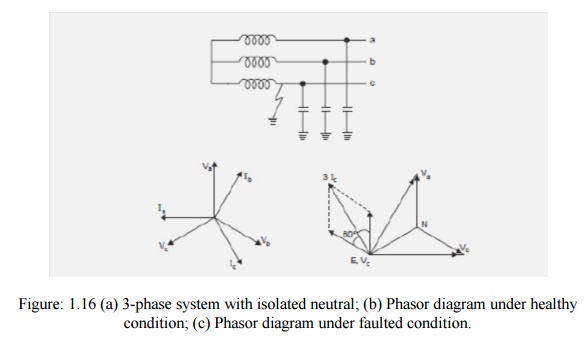The shunt capacitances are also shown. Under balanced conditions and complete transposed transmission lines, the potential of the neutral is near the ground potential and the currents in various phases through the shunt capacitors are leading their corresponding voltages by 90°. They are displaced from each other by 120° so that the net sum of the three currents is zero (Fig. 1.16 ). Say there is line-to-ground fault on one of the three phases (say phase ‘c‘).The voltage across the shunt capacitor of that phase reduces to zero whereas those of the healthy phases become line-to-line voltages and now they are displaced by 60° rather than 120°. The net charging current now is three times the phase current under balanced conditions (Fig.1.16 (c)). These currents flow through the fault and the windings of the alternator. The magnitude of this current is often sufficient to sustain an arc and, therefore, we have an arcing ground. This could be due to a flashover of a support insulator. Here this flashover acts as a switch. If the arc extinguishes when the current is passing through zero value, the capacitors in phases a and b are charged to line voltages. The voltage across the line and the grounded points of the post insulator will be the super-position of the capacitor voltage and the generator voltage and this voltage may be good enough to cause flashover which is equivalent to strike in a circuit breaker. Because of the presence of the inductance of the generator winding, the capacitances will form an oscillatory circuit and these oscillations may build up to still higher voltages and the arc may reignite causing further transient disturbances which may finally lead to complete rupture of the post insulators.


